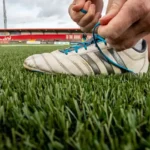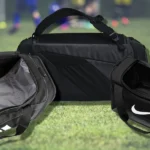Soccer shooting accuracy separates average players from those who consistently impact the scoreboard. Whether you’re a winger, striker, or even a midfielder, being able to place your shot with confidence is one of the most valuable skills. Here are five powerful techniques that will sharpen your aim and help you score more goals.
Master Your Body Position
Keep Your Head Over the Ball
Leaning back is one of the most common mistakes in shooting. Keeping your head directly over the ball helps generate a low, controlled shot. This position stabilizes your body and ensures the ball doesn’t sail over the bar. It also improves your timing and helps with better follow-through.
Non-Kicking Foot Placement
The positioning of your plant foot decides both power and direction. It should be placed about 6 to 8 inches to the side of the ball and point in the direction you want to shoot. This anchors your motion and gives you the balance to unleash a confident strike.
Engage Your Core and Shoulders
While your legs do the shooting, your core controls your posture. A strong, stable torso keeps your motion clean. Shoulders should stay square to the goal. Twisting mid-shot throws off your aim and limits power.
Refine Your Footwork
Use Controlled, Quick Steps Before the Shot
Fast, choppy steps keep you agile and in control before you shoot. Long strides tend to cause imbalance, especially when rushing toward goal. Train yourself to stay light on your feet just before striking.
Avoid Rushing the Setup
Panicking near the goal leads to mistimed shots. Even in high-pressure moments, taking an extra beat to set your feet properly improves both accuracy and confidence.
Train Both Feet
Limiting yourself to one foot makes you predictable. Practice finishing with your weaker foot regularly. It opens up more angles and options, especially when defenders cut off your dominant side.
Focus on the Ball Contact Point
Strike the Center for Power
When aiming for power, aim to strike the center or just below center of the ball. This sends it straight with backspin, reducing unpredictable movement and keeping it goal-bound.
Use the Inside of Your Foot for Placement
The inside of the foot offers the largest surface area, making it ideal for precise shots. It might sacrifice a bit of power, but it significantly increases control. This is especially useful when placing the ball in corners.
Avoid Hitting the Underside
If your foot slides too far under the ball, it causes a chipped shot. This is useful in rare situations, but most of the time, it kills your accuracy. Be deliberate with how and where your foot meets the ball.
Target Selection and Visualization
Pick a Specific Spot Before Shooting
Don’t just aim “at the goal.” Choose a specific target—bottom left, top right, just inside the post. A clear mental image helps your body naturally align the motion.
Look Up, Then Down
Glance up once to see the goalkeeper’s position, then look back down at the ball during the strike. This balance of awareness and focus is key to effective shooting.
Practice with Cones or Small Goals
Set up small zones within the goal during training. Try to hit the same target 5–10 times in a row. This builds muscle memory and simulates real-match pressure.
Develop a Reliable Shooting Routine
Use Repetition Drills
Repetition is the foundation of consistency. Regular drills focused on technique rather than power create long-term improvements. Example:
- 20 inside-foot finishes
- 10 volleys from the top of the box
- 10 weak-foot one-touch shots
Record and Analyze Your Form
Use video to spot errors in real time. Many players don’t realize how much they lean back or misplace their plant foot until they watch themselves. Break down your motion step-by-step.
Warm Up With Form-Only Shots
Before games or intense sessions, warm up with 10–15 light shots focusing only on technique. Don’t chase power. This primes your brain and muscles for proper form.
Train with Pressure Scenarios
Simulate Game Speed
Slow, relaxed shots during drills don’t prepare you for matches. Add a defender, limit your time, or have someone shout instructions mid-drill to increase mental demand.
Use Limited Time and Touch Drills
Restricting touches forces faster decision-making. Examples:
- Two-touch finish after pass
- One-touch shot after bounce
- Finish within three seconds of receiving the ball
Work on Shooting After Contact
You’ll rarely get a clean shot. Train shooting after a light bump, shove, or deflection. This builds composure and physical readiness.
Mental Composure and Confidence
Visualize Success Regularly
Take a moment before practice or games to mentally rehearse hitting the net. Picture the ball curling past the keeper. This primes your focus and builds belief.
Avoid Overthinking
Too much analysis can freeze your instincts. Focus on the basics: foot placement, eye on the ball, and follow-through. Let the rest flow.
Celebrate Progress, Not Just Goals
Track how many shots hit your target zone, not just how many go in. Building accuracy means valuing precision over flash.
Tracking Progress and Growth
Use Accuracy Charts
Create a simple chart or table to track where your shots go during training sessions:
| Shot Number | Target Zone | Result |
|---|---|---|
| 1 | Bottom Left | On Target |
| 2 | Top Right | Miss (Wide) |
| 3 | Center | Goal |
This gives visual feedback and makes patterns clear.
Set Weekly Goals
For example:
- “Hit bottom corner 8 out of 10 times”
- “Score 3 weak-foot goals this week” These small wins keep you motivated.
Train with a Purpose
Every shot in training should have a goal. Random kicks don’t help. Focused effort builds focused results.
Final Thoughts
Improving shooting accuracy in soccer isn’t magic. It’s habit. The players who score the most goals aren’t always the strongest—they’re the smartest. Pay attention to body position, footwork, ball contact, mindset, and routine. Make these five tricks part of your regular training and watch your finishing improve every week.
Want to score more? Start with one of these changes today. Then build, one goal at a time.










